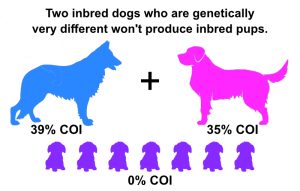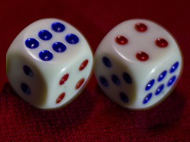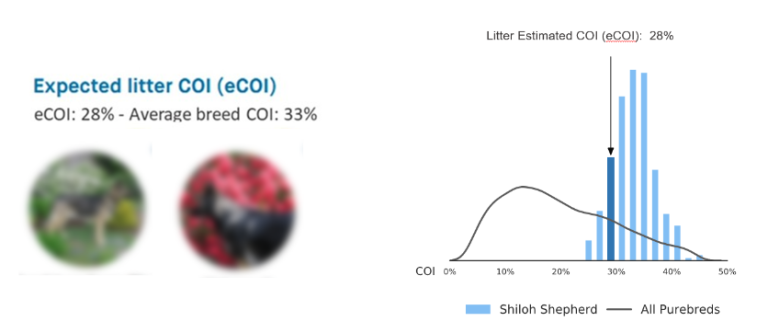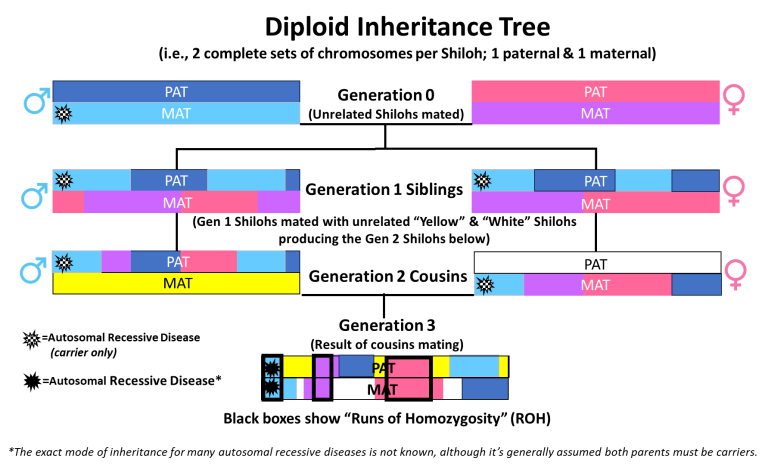FAQ

FAQs
What is a Coefficient of Inbreeding (COI)?
COI is the percent of inbreeding that a dog has. Embark’s genetic COI score is a genome-wide measurement of the actual realized inbreeding of a particular dog. The COI number reflects the percentage of the dog’s entire genome that is identical (“homozygous”) because it was inherited from ancestor(s) shared by both of its parents. The higher the percentage score, the higher the inbreeding.
Why is the Coefficient of Inbreeding so important?
Numerous studies have documented a negative effect on health and longevity as COI increases. Many believe that COI is probably the single most useful statistic for animal breeding.
Should breeders always breed for the lowest expected COI (eCOI)?
Breeding for the lowest genetic eCOI is a good goal; however, the decision is usually much more complex. Breeders are experts who balance a number of critical factors.
How does COI affect health and longevity?
Research has shown that the majority of canine genetic health disorders (anywhere from 60%-80% depending on the study) are caused by autosomal recessive mutations. In other words, unless both parents are carriers of the recessive gene, the pups will be fine.
When inbreeding occurs, it’s much more likely that both parents will carry a copy of the same deleterious recessive gene.
The higher the COI percentage, the greater the probability that two copies of the same gene have been inherited from an ancestor shared by both parents. This increases the odds of producing pups who will develop the disorder.
Can COI affect litter size?
Yes. Studies have shown that as inbreeding increases, it can lead to a reduction of litter size and reduced fertility.
Do dogs with high COIs produce pups with high COIs?
If genetic Trial Breedings are used, there’s a good chance they won’t! It doesn’t matter what the individual COIs are for the parents. What matters is how genetically-similar the two parents are to each other. In fact, in the Shiloh DNA Trial Breeding Project, some of the lowest expected COIs for litters resulted from Shiloh parents with high COIs themselves. That’s because even though they shared several ancestors, they didn’t happen to inherit very many of the same genes from their shared ancestors.
The example below shows what can happen when two inbred dogs who are genetically quite different are bred.

Can the expected COI (eCOI) for a potential litter be lower than the COIs of both parents?
Yes! We’ve seen that multiple times. It can also go the other way, with eCOIs for the potential litter being higher than both parents. It all depends on the genetic probability that the pups will inherit two copies of the same gene from a common ancestor shared by both parents. With Trial Breedings, this information can be known in advance.
Is a low COI a guarantee for health and longevity?
Statistically, the odds for health and longevity are much better with a low COI, but there are no guarantees.
For example, if you roll a pair of dice that has red numbers on only 2 sides, your odds of rolling 2 red numbers would be much less than if 4 sides were red. However, your odds would not be zero.

Is Embark's eCOI for potential litters accurate?
Yes! We ran a test of two parents and then tested three of their pups. Two pups had the exact COI that Embark had predicted, and the third pup was just a couple points off.
Embark’s testing platform is a state-of-the-art, customized Single Nucleotide Polymorphism (SNP) microarray developed in partnership with Cornell University College of Veterinary Medicine. Its processing laboratory is ISO and CLIA certified. These are the highest ratings available for commercial laboratories processing DNA samples, and are the same ratings attained by human DNA testing companies.
Are pedigree COI predictions for litters accurate?
No. Pedigree COIs rely on the false premise that ancestral DNA is inherited in a mathematically precise way, but that simply isn’t true. The actual mode of inheritance of autosomal DNA is through random recombination (see article below). The cumulative effect of this random inheritance pattern over multiple generations can be significant. This is true regardless of how accurate and complete a pedigree is.
Pedigree COIs were the best method available in the past, but thankfully we now have scientifically-based genetic expected COIs (eCOIs).
How will the potential litter's eCOI be shown in the report?
The sire and the dam will be identified, along with the expected COI (eCOI) of their potential future litter. The average for all Shilohs in Embark will be shown. There will also be a graph reflecting how the potential litter’s eCOI compares to the COIs of all Shilohs in Embark.
[Note: These examples are for illustrative purposes only and do not reflect an actual breeding pair. Photos are blurred for privacy.]

Is COI the same thing as "diversity"?
COI is a term of art in canine genetics, but “diversity” is not. “Diversity” is just a dictionary word that people use in many different ways.
There are some genetic terms of art that include the word “diversity” such as “Dog Leukocyte Antigen (DLA) Diversity” and “Breed-wide Diversity,” but the word “diversity” itself does not have a single defined meaning for canine geneticists.
Should breedings with a dog who is a known carrier of a genetically-testable disease be avoided?
No. In fact, many geneticists advise the opposite. When a dog’s genetic health results show that it’s a carrier for a disease (for example Degenerative Myelopathy (DM)), many geneticists say that it poses much less of a risk than diseases that can’t be genetically tested because it can be managed and controlled.
Two DM-recessive dogs should never be bred. However, if a DM carrier who has desirable traits can be bred to a non-carrier, and the resulting COI can be lowered, the geneticists recommend such breedings. Statistically, odds are that half the pups won’t even inherit that deleterious recessive gene. Lower COIs and preserving breed-wide diversity are generally considered more important than avoiding a recessive gene that will not cause disease in any pups. Some think that by avoiding known recessive genes, we may be inadvertently increasing our odds of unknown recessive genes.
If a dog has had a DNA test, does that mean its COI has been tested?
It depends on which company performed the test. As of this writing, of the commercially available tests, only Embark tests for COI.
How does Embark measure COI?
Embark can measure genetic COI with runs of homozygosity (ROH). Those are stretches of a chromosome where both copies (paternal and maternal) are identical by descent. [Framed black boxes for Generation 3 in the image below.] Those identical segments indicate that the two parents shared a common ancestor.
The more ROH, the greater the odds are for autosomal recessive diseases to surface.

What are some of the major contributors to inbreeding?
Studies have found that inbreeding is usually due to…
- Small, founding population, usually followed by strong selection for particular traits
- Relatively small pool of breeding dogs
- “Popular Sire Effect,” which further narrows the gene pool
- Historical events that limited breeding opportunities Examples are war, natural disasters, and even breed club splits.
Why Pedigree & Genetic COIs are so different

The fundamental problem with pedigree-based COIs is that they are unable to capture the reality of how autosomal DNA is actually inherited. Autosomal DNA (atDNA) goes through random recombination. This means a pup inherits a random half of the atDNA each of its parents inherited from their parents. Pedigree COIs cannot assess random inheritance.
Dogs have more atDNA chromosomes than people, but the inheritance pattern is the same. “Deck of Cards” is a great analogy for how autosomal DNA is inherited.
Imagine that when you (or your Shilohs) were being created, to make up your own deck of cards you got to pick 26 cards from each parent’s deck, but their cards were face-down. Now imagine their black cards were what they inherited from their father and their red cards are what they inherited from their mother. Would you pick exactly 13 black and 13 red cards from each parent’s deck? Possibly, but odds are you’d pick more of one color and less of the other.
For example, if you picked 14 black cards and 12 red cards from your father, that means you inherited more atDNA from your paternal grandfather than you did from your paternal grandmother.
Now imagine spades represent your dad’s paternal grandfather, clubs are his paternal grandmother, diamonds are his maternal grandfather, and hearts are his maternal grandmother. Even though you get 50% of your atDNA from each parent, the amount you get from each ancestor can vary significantly! That’s why we don’t look like our siblings, why pups in a litter aren’t identical, and why pedigree COIs are misleading.
Compound this random inheritance over multiple generations, and you can easily see why a genetic COI is so different from the pedigree COI for the same Shiloh. We tested this on a group of Shilohs bred by a variety of breeders, and none of the genetic COIs were even close to the pedigree COIs.

Privacy
We take privacy very seriously. We will never share or release your name or any genetic information about your Shiloh Shepherd without your prior approval.
